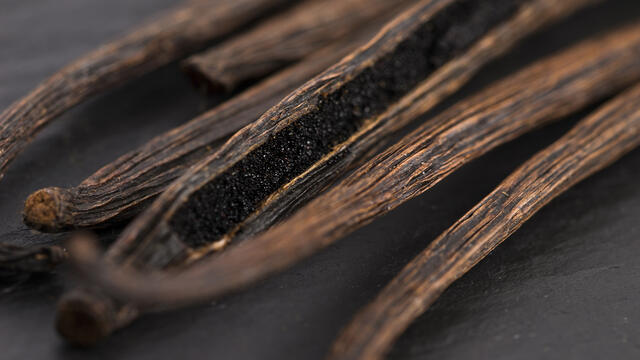Where Do Vanilla Beans Come From?
[sponsored]

When you’re indulging in a much-needed vanilla latte in the morning or notice the little specks of vanilla mixed into your ice cream, do you ever question, “Where do vanilla beans come from?”
Even though vanilla flavoring can be artificial, vanilla beans are completely natural, coming from a plant known as Vanilla planifolia. In this article, we are going to take a closer look at the origins of this magic plant and its completely to-die-for flavor.
Where Do Vanilla Beans Come From: From Mexico Around the World
While vanilla is among the most widely used natural flavors in the world, it is only cultivated in a few regions and countries, within 10-20 degrees of the equator. As with chocolate, wine, and coffee, vanilla beans from each country have their own unique characteristics and flavor profiles, owing to varying soils, growing conditions, curing methods, and vanilla species.
Vanilla beans grow green on the vine of a vanilla orchid and are harvested as soon as the tips begin to turn yellow. The curing process is what gives the beans their brown color, as well as strong flavor and aroma.
Read on to discover more about three vanilla-producing countries that supply most of the world’s vanilla beans: Mexico, Madagascar, and Tahiti.
1. Mexico: The Origin of Vanilla
Vanilla planifolia is a tropical climbing orchid native to Mexico and, for many centuries, the secret of where do vanilla beans come from was guarded by the indigenous Totonac Indians, who were later conquered by the Aztecs.
Finally, when the Aztec empire was, in turn, conquered by Hernán Cortés, vanilla bean pods were transported to Spain, introducing the flavorful beans to the rest of the world.
Nevertheless, Mexico remained the only cultivating region for vanilla beans for 300 more years due to the special symbiotic relationship between the vanilla orchid plant and Melipona – an indigenous bee native to Mexico that is the only insect in the world able to pollinate the vanilla plant.
Curing Process
The entire vanilla bean curing process is a quite labor-intensive endeavour in Mexico and takes between three to six months:
- Green vanilla beans are wrapped in straw mats and blankets and placed in the oven for 24-48 hours.
- After that, the beans are spread in the sun to absorb heat during the day and placed in large wooden boxes at night to sweat.
- Once cured, the beans are kept in conditioning boxes on racks to further develop the flavor.
Flavor Characteristics
Mexican vanilla provides a rich combination of a sweet woody character with deep-spicy notes, similar to nutmeg or clove.
2. Madagascar Bourbon: The Adoption of Hand Pollination Technique
The Bourbon islands of Madagascar include four distinct islands: Réunion, Mauritius, Seychelles, Comoro, and Madagascar itself.
In the late 18th century, a vanilla vine was brought from its birthplace in Mexico to the Réunion island of Madagascar. However, for almost five decades after its arrival, the cultivation of vanilla orchards was challenging: the vines grew well with gorgeous flowers, but very few of them resulted in vanilla pods – without the Melipone bee, a natural pollinator native to Mexico, the blossoms were only occasionally pollinated by local insects.
Only in 1841, Edmond Albious invented an efficient technique of pollinating vanilla blossoms by hand. Since then, the technique has been adopted for commercial use and has enabled Madagascar Bourbon to become the top vanilla producer in the world in terms of both quantity and quality.
Curing Process
The Madagascarian curing process is quite similar to the Mexican one with a small difference:
- The farmers start the curing process by placing the green vanilla beans under hot water for a short time.
- Then, the beans are stored in sweat boxes until starting the practice of spreading them in the sun during the day and packing them away overnight.
Flavor Characteristics
Bourbon vanilla beans are known for their rich and highly complex flavor profile with creamy, sweet, and mellow notes.
3. Tahiti: A Whole New Species of Vanilla
Today, Tahiti, an island in the southern Pacific, is a large supplier of one-of-a-kind plump vanilla beans coming from the plant called Vanilla tahitensis. However, this whole new type of vanilla plant is not native to the island. So where do these vanilla beans come from?
In 1848, Vanilla aromatica plants were brought to Tahiti; two years later, a different species of the plant were imported, known as Vanilla fragrans. After a few decades of careful cross-breeding, the Vanilla tahitensis was born.
Curing Process
The curing process of Tahitian vanilla differs significantly from that of vanilla grown in Mexico or Madagascar:
- Mature vanilla beans are stored in a cool place for 5-10 days until they turn completely brown.
- Then, the beans are rinsed with clear water – a step unique to Tahiti.
- After that, for a month, the beans are exposed to soft morning sun for 3-4 hours per day. In the afternoon, the beans are wrapped in cloth and stored in crates until the next morning.
- Slowly, the water evaporates from the beans, causing them to shrink. During this time, the vanilla pods are flattened and smoothed by hand, using the index finger and the thumb.
- After a month, the beans are left to dry in a well-ventilated and shaded spot for another 40 days.
Flavor Characteristics
Tahitian vanilla offers floral and fruity flavor with notes of almond and cherry.
Shop for Premium-Quality Vanilla Beans from Around the World
Without a doubt, the origin of where vanilla beans come from, alongside a specific curing method employed, plays a significant role in the unique flavor notes and characteristics of the final product.
At Online Baking Supplies, we are determined to deliver only premium-quality vanilla beans and natural vanilla flavors for you to enjoy. Our organic vanilla products are sourced from the world’s premier vanilla-cultivating countries, including Mexico, Madagascar, Tahiti, Uganda, and more and offer a variety of flavors – from full, rich taste to complex floral and fruity aroma. Shop for your ideal vanilla bean flavor today.
Original: https://onlinebakingsupplies.com/blogs/flavorings/where-do-vanilla-beans-come-from
Online baking supplies for all your baking needs brought to you by CakesDecor.com
